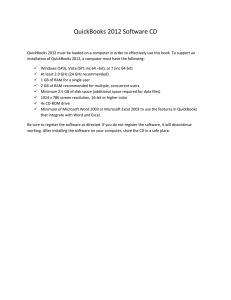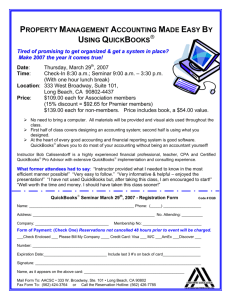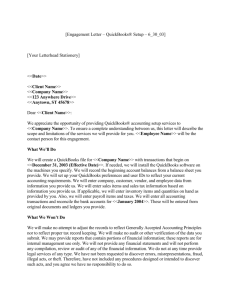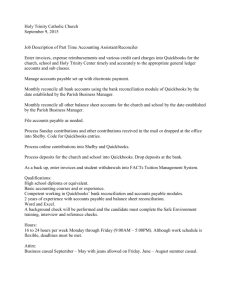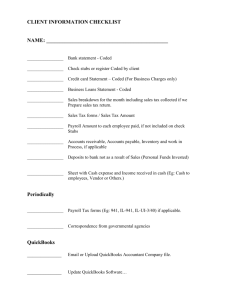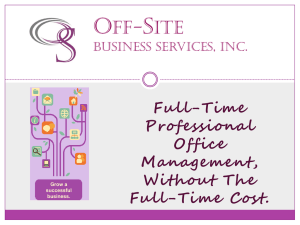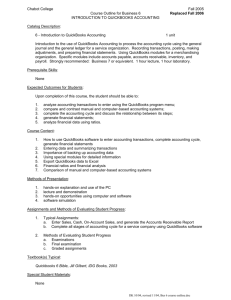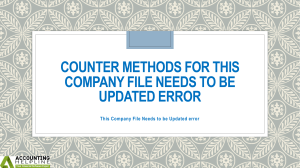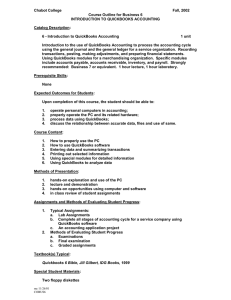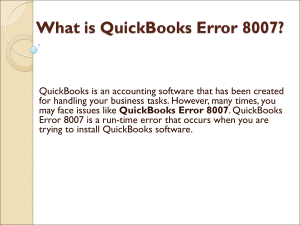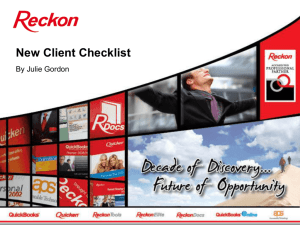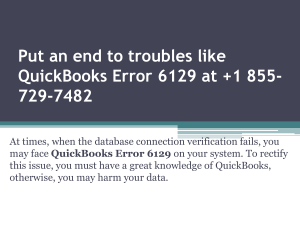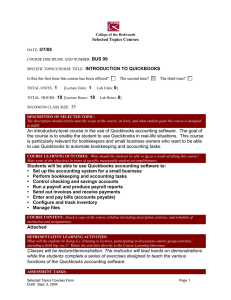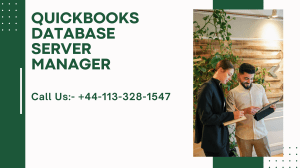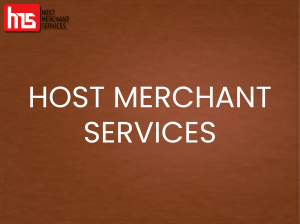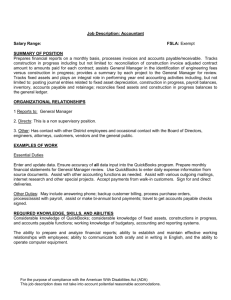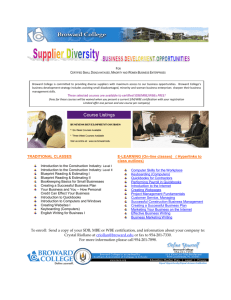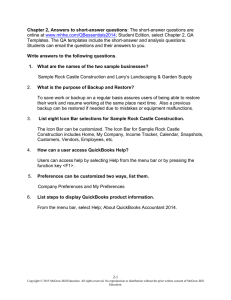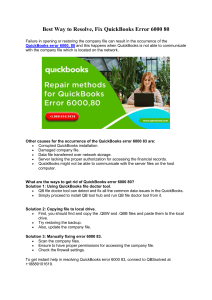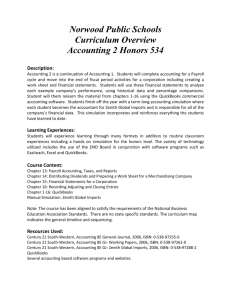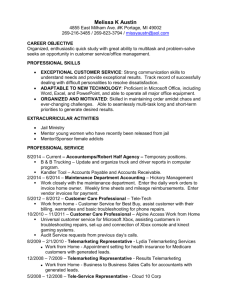Revenue Cycle
advertisement
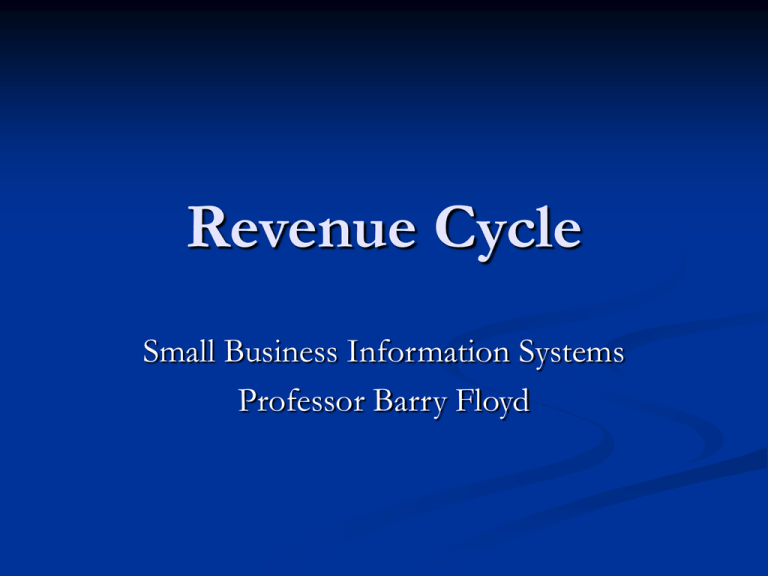
Revenue Cycle Small Business Information Systems Professor Barry Floyd Objectives Understand the notion of a ‘business process’ Identify activities and documents in the standard ‘revenue’ / ‘money in’ business process Have a general understanding the Data Flow Diagram technique of representing an information system process Discuss how the appropriate design of revenue cycle tasks can provide value Identify key reports to assess process and organizational performance in the revenue cycle Identify potential business risks (we’ll discuss how to handle them later in the quarter) See (and know) how to use QB in handle the revenue cycle References http://en.wikipedia.org/wiki/Enterprise_resource_pla nning http://www.quickbooks.com http://en.wikipedia.org/wiki/Microsoft_Dynamics http://www.microsoft.com/dynamics/default.mspx http://highered.mcgrawhill.com/sites/0072404299/student_view0/chapter8/ Agenda Understand notion of activity and process Overview of Revenue Cycle Business Activities Our goal is to identify the various activities which take place in our business and to assign a person to be responsible for assuring that activity is accomplished effectively. A business activity ... produces some clearly identifiable result (product, idea, decision, and so on). An activity has clear boundaries--there is a beginning and an ending. Activities don’t overlap. An activity is carried out as a unit, by a single person or a team. Once initiated, an activity proceeds largely independently of other activities. Example Business Activities Add a customer to our customer list Send a bill to a customer Throw out broken lamp from inventory Select a new vendor to purchase from Update the credit amount for a customer and more! Grouping Business Activities Business activities are typically grouped into what are called business processes (and subprocesses) and can also be referred to as a cycle Historically business processes are typically grouped into what are called business functions. For example... We could have a group of activities such as evaluate vendors select vendor generate purchase order grouped into the business process PURCHASING where Purchasing was one process in the function MATERIALS MANAGEMENT The issue now, is that we have business processes that span business functions … for example marketing should talk more with production to both build and sell products. So What? Your goal in your business is to determine where information technology can be effective. Given that the business is new, you need to `create it’. To create it, I ask that you describe the main activities of your business and assign them to someone in your organization. You can do this at the level that makes sense to you -- activities, processes or functions. Later, you will evaluate which activities QuickBooks and Great Plains supports. QuickBooks Money In Key activities/processes in the revenue cycle The primary objective of the revenue cycle is to provide the right product in the right place at the right time for the right price Accounting oriented tasks include: Sales Order Entry Shipping Billing and accounts receivable Cash collections What marketing / analysis tasks exist? We’ll talk about this a bit later … Data Flow Diagram of Revenue Cycle Overview Diagram What is a dataflow diagram? Level 0 Diagram Level 1 Diagram – Order Level 1 Diagram – Pick Level 1 Diagram – Billing Data Flow Diagrams A diagramming to show how a system ‘works’ by showing four different part of the system: Processes Data stores Files, databases, file folders … anything that holds data Data flows activities like entering a sales order Movement of data from one activity to another External entities People, departments, companies … who receive data from us or send data to us and we are not concerned about what they do to give us the data or what they do when they get our data Different ‘levels’ of DFDs The process B is broken into three smaller substeps … This ‘leveling’ is done to reduce the complexity of a diagram on a page. A D z x B C y x B.2 z B.1 B.3 y Key Documents Estimate – offer of goods/services at a price for a specific period of time Invoice – request to pay Credit Memo – supports adjustments to customer accounts Bill of Lading – legal doc to transfer ownership to shipping company Packing slip – states what is send Order – customer request for goods / services Backorder – out of stock … buy more Remittance advice – receive cash Sales Return Authorization – Approval document that return is allowable Technology Take a few minutes and discuss with those at your table, places in this business process where you think technology can play a role to … Reduce costs. Add additional value to the customer. Provide better information to management. QuickBooks’ Response Let’s see how QuickBooks supports the Revenue Process. QuickBooks Tasks Add a new product Add an income account for this product Create an estimate for a customer Change the status of the estimate Do the work Invoice the customer Receive payment Deposit the $$$ into our bank account Some Key Decisions How could you improve customer service? What information does Marketing need to perform its tasks better? How could you identify your most profitable customers and markets? How can you improve your monitoring of credit accounts? How would any changes in credit policy affect both sales and uncollectible accounts? How could you improve its cash collection procedures? Reports What would you want to know about this process to see if it is performing ‘well’? What metrics are important to you? Why? Which ones are most important to your business? Why? What reports does QuickBooks provide? Are they adequate? Summary The revenue cycle is an important cycle to understand. Failure to manage your business’ cash flow leads to failure. Understanding the use of technology is important for both reducing costs and for improving customer service and differentiating your business from your competitors.
